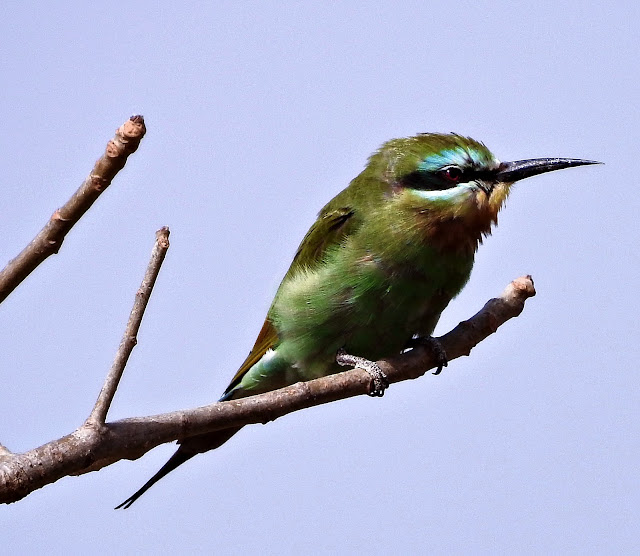The village weaver (Ploceus cucullatus), also known as the spotted-backed weaver or black-headed weaver (the latter leading to easy confusion with P. melanocephalus), is a species of bird in the family Ploceidae found in much of sub-Saharan Africa. It has also been introduced to Portugal and Venezuela as well as to the islands of Hispaniola, Martinique, Puerto Rico, Mauritius and Réunion.
This often abundant species occurs in a wide range of open or semiopen habitats, including woodlands and human habitation, and frequently forms large noisy colonies in towns, villages, and hotel grounds. This weaver builds a large coarsely woven nest made of grass and leaf strips with a downward-facing entrance, which is suspended from a branch in a tree. Two or three eggs are laid. Village weavers are colonial breeders, so many nests may hang from one tree.
Village weavers feed principally on seeds and grain, and can be a crop pest, but readily take insects, especially when feeding young, which partially redresses the damage to agriculture. The calls of this bird include harsh buzzes and chattering.
The village weaver is among the more common weaver species, and is widespread in sub-Saharan Africa, but is absent from the arid regions in the southwest and northeast. It has been introduced to islands in the Indian Ocean and the Caribbean, where it has adapted well to the climates similar to its original range.
Village weavers forage and roost in large groups, often with other weaver species. In some areas, they move periodically along fixed routes. The birds look for food on the ground, but also look up to search vegetation and trees. Village weavers nest in colonies and are very active during the breeding season. Birds fly in and leave again constantly, making significant noise. Colonies can contain as many as 150 nests, but eight to a hundred nests in a single tree are usual.
A village weaver's nest is 14–17 cm (5.5–6.7 in) long and 11–13 cm (4.3–5.1 in) high. The entrance is mostly extended into a tube of 4–8 cm (1.6–3.1 in) long. The male weaves the structure of the nest using long strips of leaf that he has torn from palms or large grass species such as Arundo donax. The nest is roofed, ovoid or kidney-shaped, internally consisting of a nesting chamber that is separated by a ground sill from an antechamber, that has the entrance of the entire nest at the bottom. On the inside, the ceiling is made of strips of grass or other leaves, which are simply inserted instead of woven in. The floor on the inside is lined by short, thatched strips of palm, grass blades or heads, and feathers. The nest requires about 300 long strips of leaf, which the male tears off and transports one by one. The male gathers building material throughout the building process, during which he works with his feet in exactly the same position, and maintaining the same orientation. He starts by creating the attachment by weaving around mostly two hanging branches just below a fork, a foot on both of them, which he includes in a ring he constructs by weaving in the plain of the branches at the edge of his reach. He than extends the high end of the ring in front of its head, gradually working towards his feet creating a half-globe that is the nesting chamber. The male continues by constructing the roof of the antechamber, working over his head. This is followed by lining the ceiling, and constructing the entrance tube, hanging upside-down, but still with his feet at the same spots. The weaving technique consists of seizing a strip of near the end and double the strip back on itself. Next he pokes the end with a vibrating movement in between his previous work until it sticks. He then release it, moves his head to the other side of the nest wall, seizes the strip again, and pokes it in somewhere. He keeps repeating this, regularly reversing the direction in which he weaves the strip, poking and pulling the strip through holes until the entire length is used. The female collects material, too, but she occupies herself only with the lining of the nesting cup.























1.jpg)






















